The High Stakes of a Failing Commercial Refrigerator
When your commercial refrigerator not cooling properly, you're facing more than just an inconvenience - you're staring at potential disaster for your business. A malfunctioning fridge can lead to spoiled inventory, lost revenue, and even health code violations that could shut down your operation.
Quick troubleshooting checklist for a commercial refrigerator not cooling:
- Check power supply - Ensure unit is plugged in and circuit breaker hasn't tripped
- Verify thermostat settings - Should be set to 40°F or lower per FDA guidelines
- Inspect door gaskets - Look for cracks, tears, or gaps allowing warm air in
- Clear blocked vents - Remove any food items obstructing airflow
- Clean condenser coils - Dirty coils can't release heat effectively
- Check for frost buildup - Excessive ice blocks proper air circulation
The stakes couldn't be higher. The FDA recommends keeping refrigerator temperatures at 40°F or lower to prevent foodborne illness. When your commercial unit fails to maintain these critical temperatures, you risk not just financial losses but also the health and safety of your customers.
Commercial refrigerators work harder than residential units, running continuously under demanding conditions. They're designed for heavy-duty use, but like any complex system, they need proper maintenance and quick attention when problems arise.
I'm Tony Lara, and in my years working in the HVAC field, I've helped countless businesses diagnose and resolve issues with their commercial refrigerator not cooling systems. My hands-on experience has taught me that most cooling problems can be prevented with proper maintenance, but when they do occur, quick action is essential to minimize business disruption.
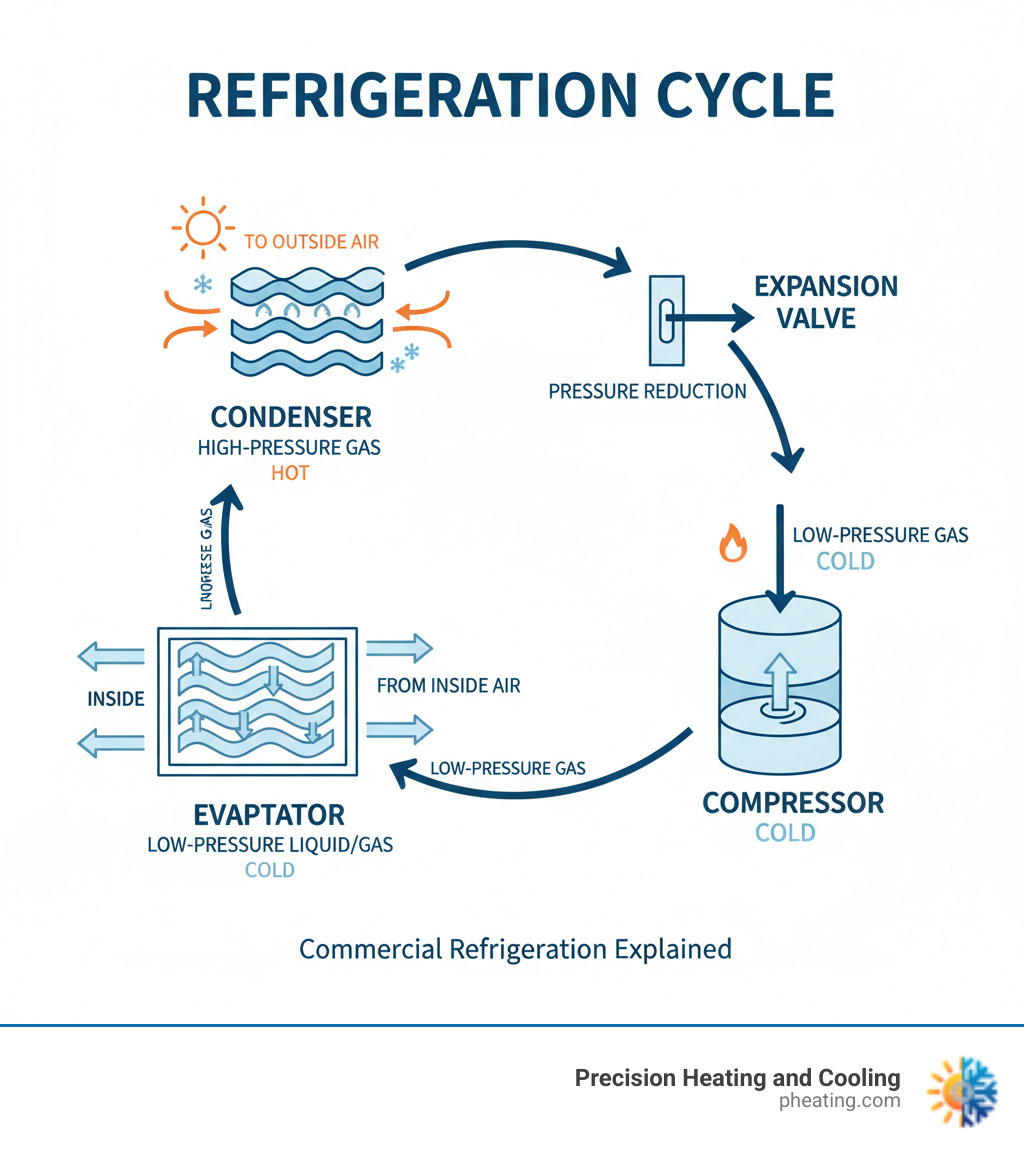
Easy commercial refrigerator not cooling word list:
First-Response Troubleshooting: Simple Fixes You Can Do Right Now
When your commercial refrigerator not cooling properly, don't panic just yet. Before calling in the professionals, there are several straightforward troubleshooting steps that might save your day (and your inventory). Think of these as your first line of defense against a cooling crisis.
Safety first, though. Before you start poking around, always unplug your unit from the power source. This simple step protects you from electrical shock and prevents any accidental damage to your refrigerator's components.

Start with the most obvious culprit: power supply issues. Is your unit actually getting electricity? Sometimes the simplest problems have the simplest solutions. Check if the refrigerator is properly plugged into a working outlet - you'd be surprised how often a loose connection is the villain here.
If the interior light doesn't come on when you open the door, you've got a clear sign of power trouble. Head to your electrical panel and look for any tripped circuit breakers. A quick reset might be all you need to get back in business.
Here's a pro tip: never use an extension cord with your commercial refrigerator. These units draw significant power, and extension cords can cause voltage drops that lead to cooling problems. Plus, it might void your warranty.
Take a look at how you've been stocking your unit too. Overstuffed refrigerators are struggling refrigerators. When you cram every shelf full or push items against the back wall, you're blocking the internal vents that circulate cold air. Your refrigerator needs room to breathe, just like you do. Understanding Proper Placement of Commercial Refrigeration Units can make a world of difference in performance.
Checking and Adjusting Thermostat Settings
Here's something that happens more often than you'd think: someone accidentally bumps the thermostat, and suddenly your commercial refrigerator not cooling becomes a mystery. Before you assume the worst, double-check those temperature settings.
Digital thermostats are pretty straightforward once you know the dance. Usually, you'll press a 'P' button, use the arrow keys to adjust your temperature, then press 'P' again to lock it in. Manual thermostats with old-school dials might need a screwdriver - turn clockwise for colder temperatures, counter-clockwise for warmer.
The FDA isn't messing around when it comes to food safety. Your refrigerator should be set to 40°F or lower, while freezers need to hit 0°F. These aren't suggestions - they're requirements for keeping your customers safe and your business compliant.
But here's the thing that trips up a lot of folks: after you adjust the thermostat, you need to be patient. It can take up to 24 hours for the internal temperature to stabilize and equalize throughout the unit. Don't panic if you don't see immediate results.
If your unit keeps struggling with temperature swings even after proper adjustment, check out our detailed guide on Temperature Fluctuations Commercial Refrigeration Units for deeper insights.
Inspecting Door Gaskets for a Proper Seal
Those rubber strips around your refrigerator door might not look like much, but they're working overtime to keep your unit efficient. Door gaskets create an airtight seal that keeps cold air in and warm, humid air out. When they fail, your refrigerator works harder and struggles to maintain proper temperatures.
Over time, gaskets become the victims of daily wear and tear. They crack, tear, become loose, or lose their flexibility. The result? Warm air sneaks in, condensation builds up, frost accumulates, and your energy bills climb.
Here's a simple test that'll tell you everything you need to know: the dollar bill test. Close your refrigerator door on a dollar bill, then try to pull it out. If the bill slides out easily, your gasket isn't sealing properly. Walk around the entire door doing this test - you might find some spots seal fine while others don't.
While you're at it, give those gaskets a visual inspection. Look for obvious cracks, gaps, or tears. Regular cleaning with mild soap and water helps extend their life, and a thin layer of petroleum jelly can keep them flexible and sealing properly.
When gaskets fail, they're often behind the Energy Loss Signs in Commercial Refrigeration that smart business owners learn to recognize early.
Ensuring Proper Airflow and Ventilation
Think of airflow as the circulatory system of your commercial refrigerator. Without proper circulation, cold air can't reach every corner of your unit, creating those frustrating warm spots that put your inventory at risk.
Internal airflow gets blocked more easily than you might think. When shelves are packed tight or items are shoved against the back wall, they block the internal air vents that distribute cold air throughout the compartment. Your refrigerator needs space to work - aim for at least an inch between food items and the walls.
External ventilation is just as critical, but it's often overlooked. Your refrigerator generates heat as part of the cooling process (that's basic physics), and this heat needs somewhere to go. If your unit is squeezed too tightly against walls or other equipment, it can't dissipate heat properly.
Most manufacturers recommend at least ½-inch of clearance on each side and 1-inch on the top and back. Units with rear-mounted condensers might need up to six inches from the wall. It sounds like a lot, but proper clearance is essential for optimal performance.
When ventilation goes wrong, the effects ripple through your entire system. Poor airflow forces your compressor to work harder, reduces efficiency, and can eventually lead to component failure. Our article on How Poor Ventilation Affects Commercial Refrigeration dives deeper into why this seemingly simple factor is so crucial for keeping your commercial refrigerator not cooling problems at bay.
Key Maintenance Tasks for a Commercial Refrigerator Not Cooling
Even with perfect thermostat settings and pristine gaskets, your commercial refrigerator not cooling could be due to a lack of routine maintenance. Think of it like your car - you wouldn't skip oil changes and expect it to run smoothly, right? The same principle applies to your commercial refrigeration equipment.
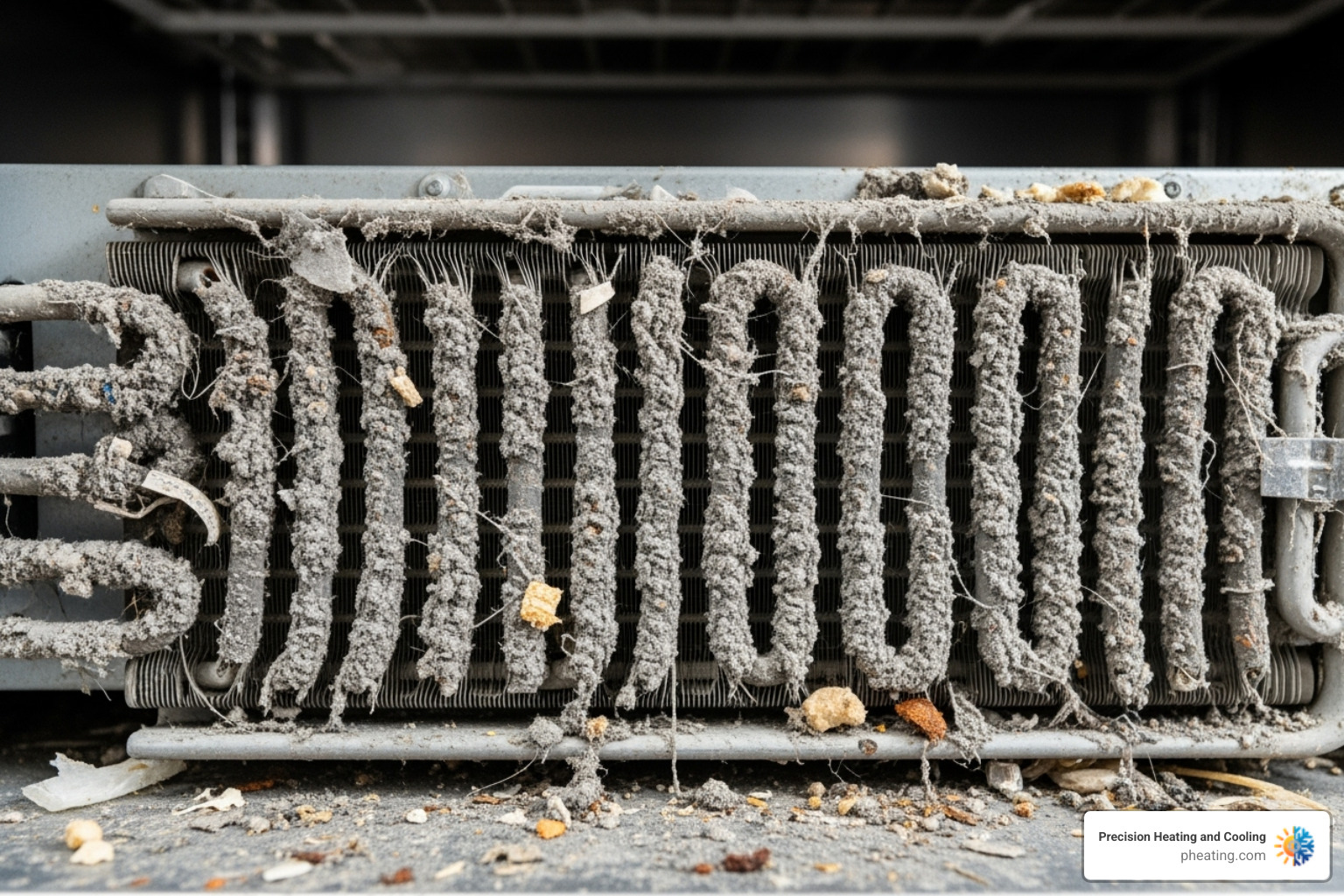
Regular cleaning and attention to specific components can mean the difference between smooth operation and a costly emergency repair. The heat exchange process that keeps your food cold depends on several components working in harmony. When dust, grease, and debris interfere with this process, your refrigerator has to work overtime just to maintain basic temperatures.
Preventative maintenance isn't just about avoiding breakdowns - it's about keeping your energy costs down and extending your equipment's lifespan. A well-maintained commercial refrigerator can serve your business reliably for 10-15 years. Neglect it, and you might find yourself dealing with Signs Commercial Refrigeration Requires Repair much sooner than expected.
How to Clean Dirty Condenser Coils
Here's something that might surprise you: those condenser coils on your refrigerator are basically radiators. Just like the radiator in your car, they need to stay clean to do their job properly. When they're clogged with dust, grease, or debris, your commercial refrigerator not cooling efficiently becomes almost inevitable.
These coils are where all the heat from inside your refrigerator gets released to the outside air. Picture trying to breathe through a dirty air filter - that's essentially what happens when your condenser coils are blocked. The compressor has to work harder and harder, generating more heat and using more energy, until eventually something gives out.
In busy commercial kitchens, condenser coils can get dirty surprisingly fast. Grease particles from cooking, dust from foot traffic, and general debris all contribute to reduced efficiency. Cleaning frequency should be every 3-6 months for most businesses, but high-traffic kitchens might need monthly cleaning.
The cleaning process is straightforward but makes a huge difference. First, always unplug the unit for safety. Locate your coils - they're usually on the back or underneath behind a removable panel. Use a special brush designed for condenser coils to gently remove the buildup, then vacuum away all the loosened debris with a brush attachment.
Don't rush this step - thorough cleaning now prevents overheating later. Once you've removed all visible dirt and debris, replace any panels and plug the unit back in. You'll often notice improved cooling performance within a few hours.
Addressing Frost and Ice Buildup
Ice buildup in your commercial refrigerator is like having a thick winter coat wrapped around your cooling coils - it blocks the very thing you're trying to achieve. When frost accumulates on the evaporator coils, it acts as insulation, preventing proper heat absorption and restricting the airflow your system needs to function.
Your commercial refrigerator should have an automatic defrost system that handles this problem before it gets out of hand. This system includes a defrost timer that initiates melting cycles, a defrost heater that does the actual melting, and sensors that monitor the process. When everything works properly, you'll never notice these brief defrost cycles happening.
But when the defrost system malfunctions, ice builds up quickly. You might see thick frost coating the back wall of your freezer section or ice blocking the internal fans. This restricted airflow is often why a commercial refrigerator not cooling evenly - some areas get cold air while others don't.
If you're dealing with excessive ice buildup, the safest approach is manual defrosting. Unplug the unit and leave the doors open for 24-48 hours, placing towels and trays to catch melting water. Never try to chip away ice with sharp objects - you could puncture the coils and create a refrigerant leak, turning a simple maintenance task into an expensive repair.
For persistent ice problems, the issue often lies with the defrost timer or control board. You can sometimes test the defrost timer by manually advancing it, but these components typically require professional diagnosis and replacement. Our comprehensive guide on how to Prevent Ice Buildup in Commercial Refrigeration offers more proactive strategies to keep your system running smoothly.
Diagnosing Major Component Failures
When simple fixes don't resolve your commercial refrigerator not cooling problem, it's time to look deeper. Sometimes the issue lies with major components that require more advanced troubleshooting. While these repairs often need professional expertise, understanding what might be wrong helps you make informed decisions about your next steps.
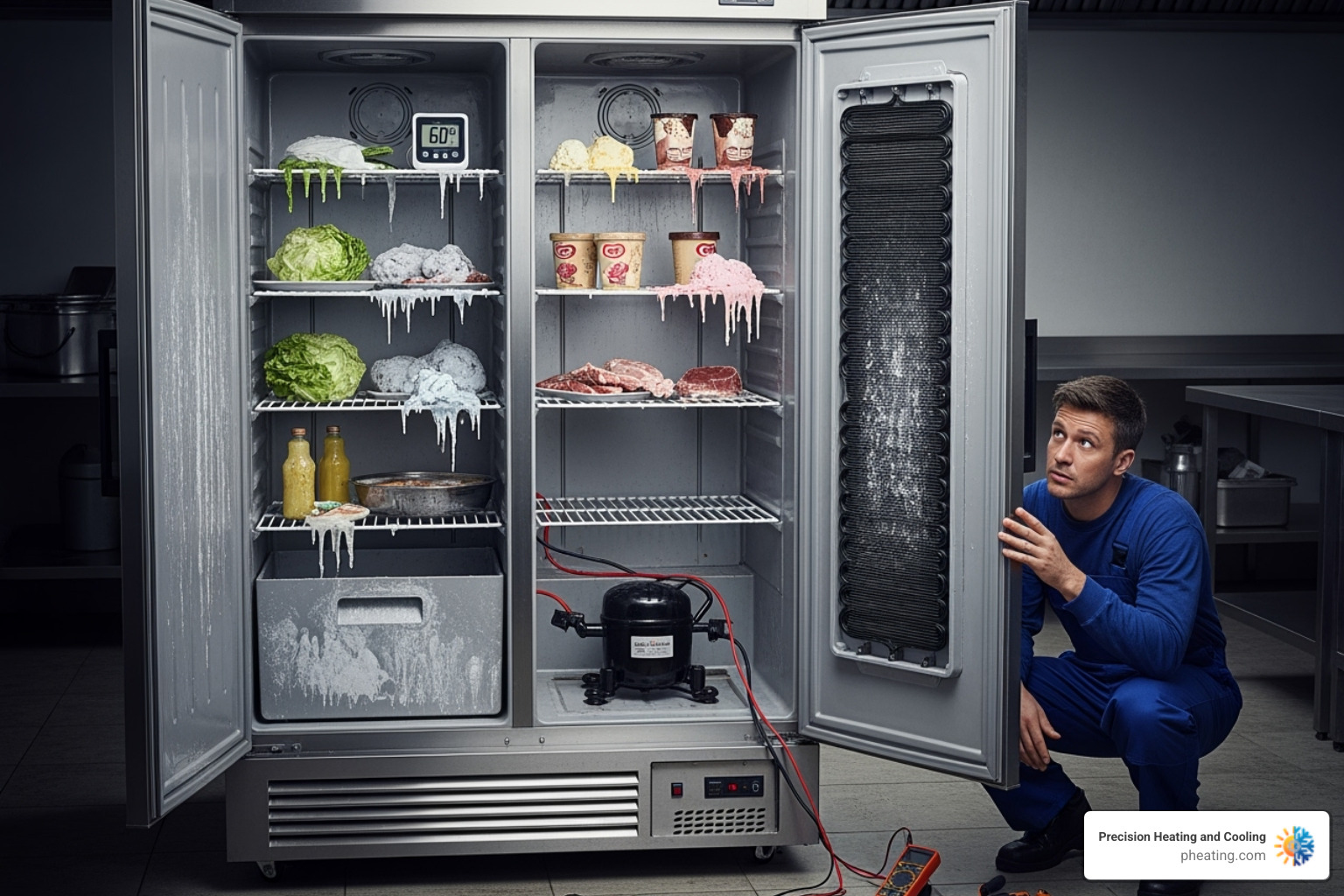
Think of your commercial refrigerator like a well-orchestrated team. When one key player fails, the whole operation suffers. The good news? Many component failures give you warning signs before they completely break down. Learning to recognize these early signals can save you from complete system failure and emergency repair calls.
Major component diagnostics can be tricky territory. While we'll walk you through what to look for, working with electrical components and refrigerant systems requires proper training and tools. For comprehensive repairs performed safely and correctly, check out How We Perform Commercial Refrigeration Repair.
What to Do for a Commercial Refrigerator Not Cooling Due to Fan Issues
Your commercial refrigerator not cooling might be crying out for help through its fan system. These hardworking components are like the lungs of your refrigeration system, and when they fail, everything suffers.
Your unit relies on two critical fans working in harmony. The condenser fan lives near the compressor and condenser coils, usually tucked away at the bottom or back of your unit. This fan's job is pulling air across the hot compressor and through the coils to release heat. When it fails, your compressor starts overheating, and temperatures inside climb fast.
The evaporator fan works inside the freezer compartment, pulling air across those icy evaporator coils and circulating chilled air throughout your entire unit. This little workhorse is often the culprit when your freezer stays cold but your refrigerator section warms up.
Listen to your refrigerator - it's trying to tell you something. Grinding, buzzing, or squealing sounds often signal a fan motor on its last legs or blades hitting an obstruction. If you can't feel air movement from the vents or notice the fan blades aren't spinning freely (check this only after unplugging the unit!), you've found your problem.
Before assuming the worst, check for simple obstructions first. Sometimes a piece of packaging or accumulated debris blocks the fan blades. If the path is clear but the fan still won't run, the motor itself has likely failed. While some handy folks can tackle fan motor replacement, it requires caution and the right tools. If you're considering a DIY approach, resources like Replace the evaporator fan motor can guide you through the process safely.
Understanding Compressor and Control Board Problems
The compressor earns its nickname as the "heart" of your refrigeration system because it pumps refrigerant through the entire cycle. When your commercial refrigerator not cooling but humming constantly, your compressor might be struggling to do its job.
Compressor troubles show up in different ways. Sometimes the compressor runs non-stop but can't compress refrigerant effectively anymore. Other times, it won't start at all due to electrical issues, a faulty start relay, or complete compressor failure. The start relay gives your compressor the electrical boost it needs to fire up - when this small but crucial part fails, your compressor sits silent.
Control board problems are trickier to diagnose because this electronic brain manages everything from compressor operation to defrost cycles. When control boards go bad, you might see erratic temperatures, components that won't turn on, or a completely unresponsive unit. These failures are less common but can cause confusing symptoms that seem to point everywhere except the real problem.
Here's a simple trick that sometimes works: if your refrigerator seems completely unresponsive, try unplugging it for several minutes before plugging it back in. Power surges or electrical hiccups can cause control boards to "lock up," and this reset might bring your unit back to life.
Compressor and control board diagnosis requires specialized tools and expertise. These components carry hefty price tags, and misdiagnosis can lead to expensive mistakes. For detailed information on recognizing serious system problems, read our guide on Signs Your Commercial Refrigeration System is Failing.
Identifying a Refrigerant Leak
Refrigerant is the lifeblood of your cooling system - the chemical that absorbs heat inside your unit and releases it outside. When this vital fluid leaks out, your commercial refrigerator not cooling effectively becomes inevitable.
Refrigerant leaks announce themselves in several ways. The most obvious sign is poor cooling performance - your refrigerator simply can't reach proper temperatures or takes forever to cool down. You might hear faint hissing or bubbling sounds as refrigerant escapes from damaged coils or connections.
Look for oily residue around coils and fittings. Refrigerant contains oil that leaves telltale films when it leaks. Uneven frost patterns on evaporator coils can also signal low refrigerant levels, as the remaining refrigerant can't properly cool the entire coil surface.
Refrigerant leaks demand immediate professional attention for several critical reasons. Many refrigerants are potent greenhouse gases that harm the environment when released. Some can be dangerous to breathe, especially in enclosed spaces. Most importantly, leak detection and repair requires EPA-certified technicians with specialized equipment.
Never attempt DIY refrigerant repairs. Professional technicians can safely locate leaks, repair them properly, and recharge your system with the correct refrigerant type and amount. For comprehensive information about this serious issue, check out our detailed article on Refrigerant Leaks in Commercial Refrigeration.
Frequently Asked Questions about Commercial Refrigerator Cooling Issues
When your commercial refrigerator not cooling properly, you probably have questions racing through your mind. Here are the most common concerns I hear from business owners, along with practical answers that can help you get back on track quickly.
What's the first thing to check if my commercial refrigerator isn't cooling?
Start with the basics - it might sound obvious, but the power supply is your first checkpoint. Make sure the unit is firmly plugged into a working outlet. I've seen countless service calls that could have been avoided if someone had just checked that the plug hadn't worked loose from vibration.
Next, head to your electrical panel and check the circuit breaker. Commercial refrigerators draw significant power, and breakers can trip, especially during peak usage times or power fluctuations. If the breaker has tripped, reset it and see if that solves your problem.
Don't forget to verify your thermostat setting - it's surprisingly easy for busy staff to accidentally bump the temperature control. The setting should be 40°F or lower for refrigerator sections.
One more thing to consider: your unit might simply be in a defrost cycle. During this normal operation, cooling temporarily pauses while the system melts away frost buildup. This typically lasts 15-30 minutes, so give it a bit of time before assuming there's a problem.
Why is my freezer cold but the refrigerator section is warm?
This frustrating scenario is actually quite common, and the good news is that it often points to a fixable issue. When your freezer works fine but the refrigerator section stays warm, you're dealing with an airflow problem rather than a complete system failure.
The most likely culprit is blocked airflow. Cold air typically flows from the freezer section to the refrigerator compartment through internal vents. When food items are packed too tightly or pushed against these vents, they create a barrier that prevents proper air circulation.
A faulty damper control could also be the issue. This component regulates how much cold air flows from the freezer to the fridge section. When it gets stuck or malfunctions, the refrigerator section gets starved of cold air.
Don't overlook the evaporator fan inside your freezer compartment. This fan is responsible for circulating cold air throughout both sections. If it fails, cold air stays trapped in the freezer area and never makes it to the refrigerator section.
Excessive frost buildup on the evaporator coils can also block airflow, even if the fan is working properly. This usually indicates a problem with your defrost system - whether it's the defrost timer, heater, or thermostat that's malfunctioning.
How often should I clean the condenser coils?
Your condenser coils need attention every three to six months to keep your commercial refrigerator not cooling from becoming a reality. Think of these coils as your unit's lungs - when they're clogged with dust and debris, your refrigerator can't breathe properly.
However, your specific environment might demand more frequent cleaning. High-traffic commercial kitchens generate more grease and airborne particles that stick to coils faster. If you're dealing with dusty storage areas or locations where there's significant pet hair in the air, you might need to clean every three months instead of six.
Grease buildup is particularly problematic in restaurant environments. It acts like a magnet for dust and creates a thick, insulating layer that prevents proper heat exchange. The harder your coils work to release heat, the more strain you're putting on your entire system.
Regular cleaning isn't just about preventing breakdowns - it also keeps your energy bills in check and extends your equipment's lifespan. A little preventive maintenance goes a long way toward avoiding those emergency repair calls that always seem to happen at the worst possible moments.
Conclusion: Keep Your Business Running with Reliable Refrigeration
When your commercial refrigerator not cooling properly, it's like watching your profits melt away in real time. We've walked through everything from the simple fixes you can tackle yourself to the complex issues that need professional attention, and one thing is clear: staying ahead of problems is always better than playing catch-up.
The good news? Most cooling issues are preventable with regular attention. Those thermostat checks we talked about, keeping an eye on your door gaskets, and making sure your condenser coils aren't buried under dust and grime - these simple habits can save you from major headaches down the road.
But let's be honest about when to wave the white flag. Refrigerant leaks, compressor failures, and control board malfunctions aren't weekend DIY projects. These are the moments when calling in the pros isn't just smart - it's essential for your safety and your wallet. Trying to fix these complex systems yourself often leads to bigger problems and higher repair bills.
Here's something else to consider: if your commercial refrigerator is constantly giving you trouble or it's getting up there in years, you might be throwing good money after bad. Sometimes the kindest thing you can do for your budget is to let an old unit retire gracefully. Our guide on When to Consider Commercial Refrigeration Replacement can help you figure out if it's time to make that call.
At Precision Heating and Cooling, we've been helping businesses in the San Jose Bay Area and Central Valley keep their cool for over two decades. We serve San Jose, Cupertino, Los Gatos, Clovis, Palo Alto, Santa Clara, Sunnyvale, and Hanford, California, and we understand that when your refrigeration goes down, every minute counts.
Your business depends on reliable refrigeration, and you deserve a team that gets that. Whether it's a quick fix or a complex repair, we're here to get you back up and running. Don't let a commercial refrigerator not cooling put your business at risk. For expert commercial refrigeration repair in San Jose, contact us today! We'll help keep your operation running smoothly, so you can focus on what you do best.

Flexible payment options to make your goals affordable and stress-free.

Warm Up Your Home: Expert Furnace Repair in Sunnyvale, Cupertino, and More
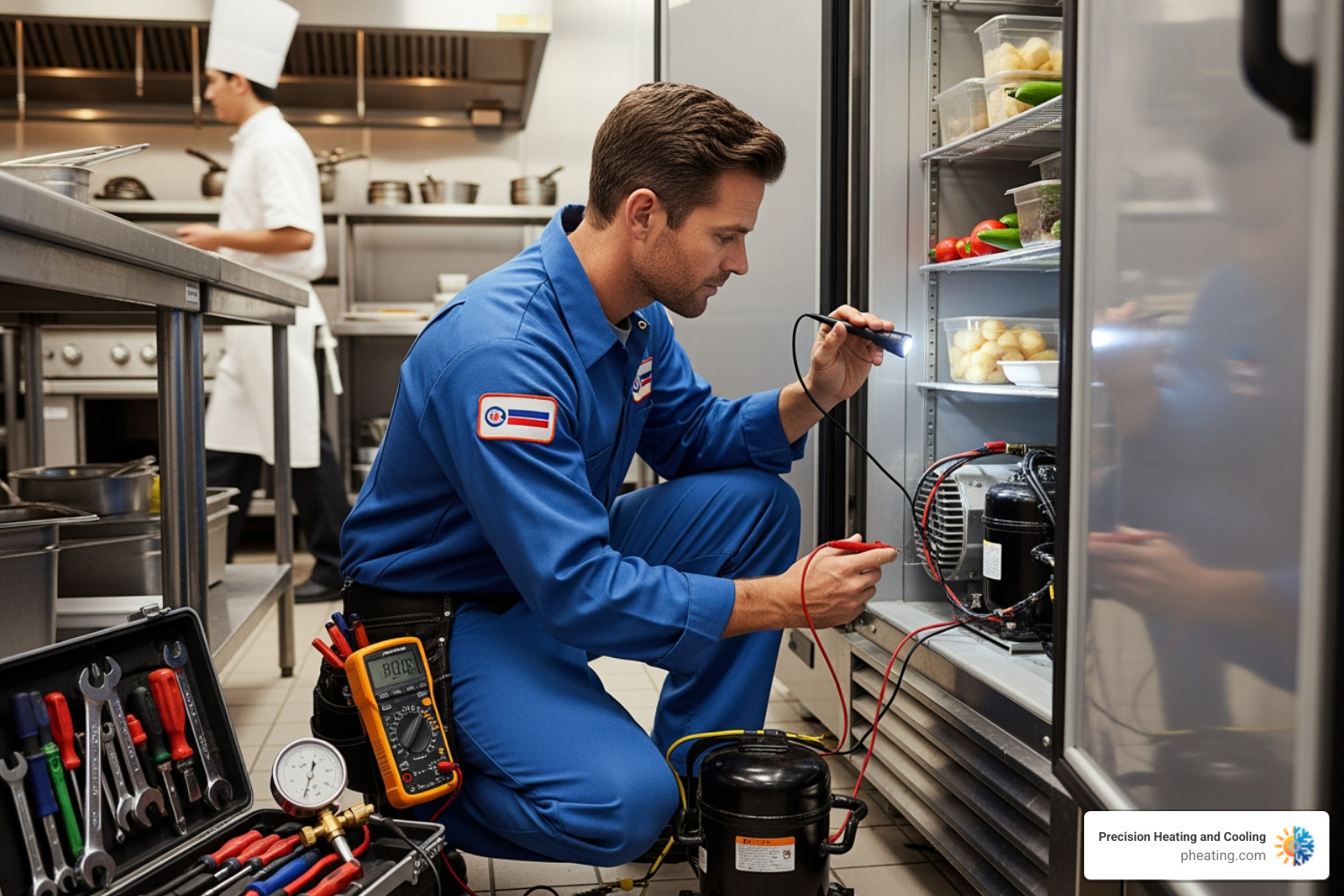
Commercial Refrigeration Repairman: What It Takes to Fix the Chill
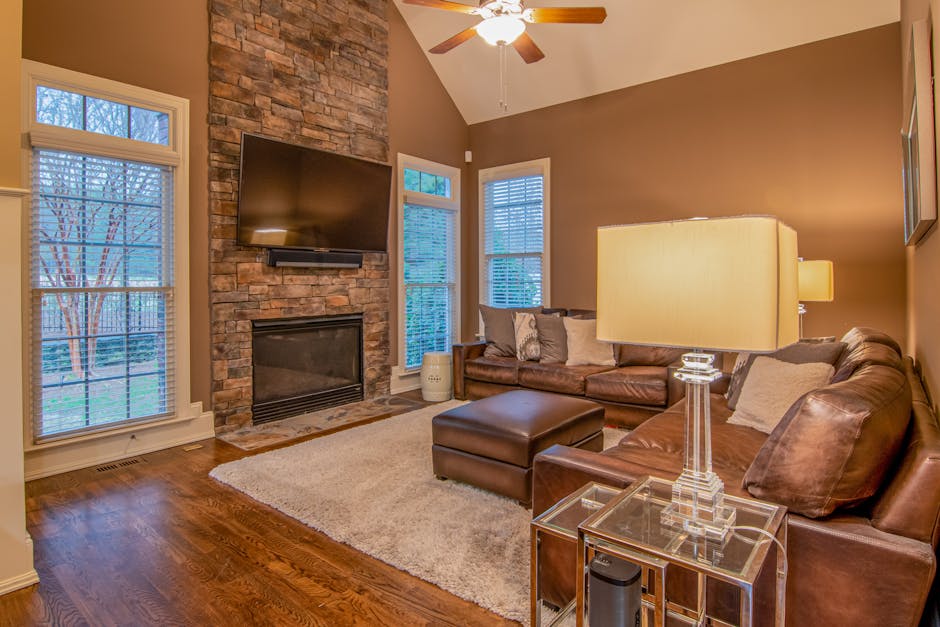












.avif)

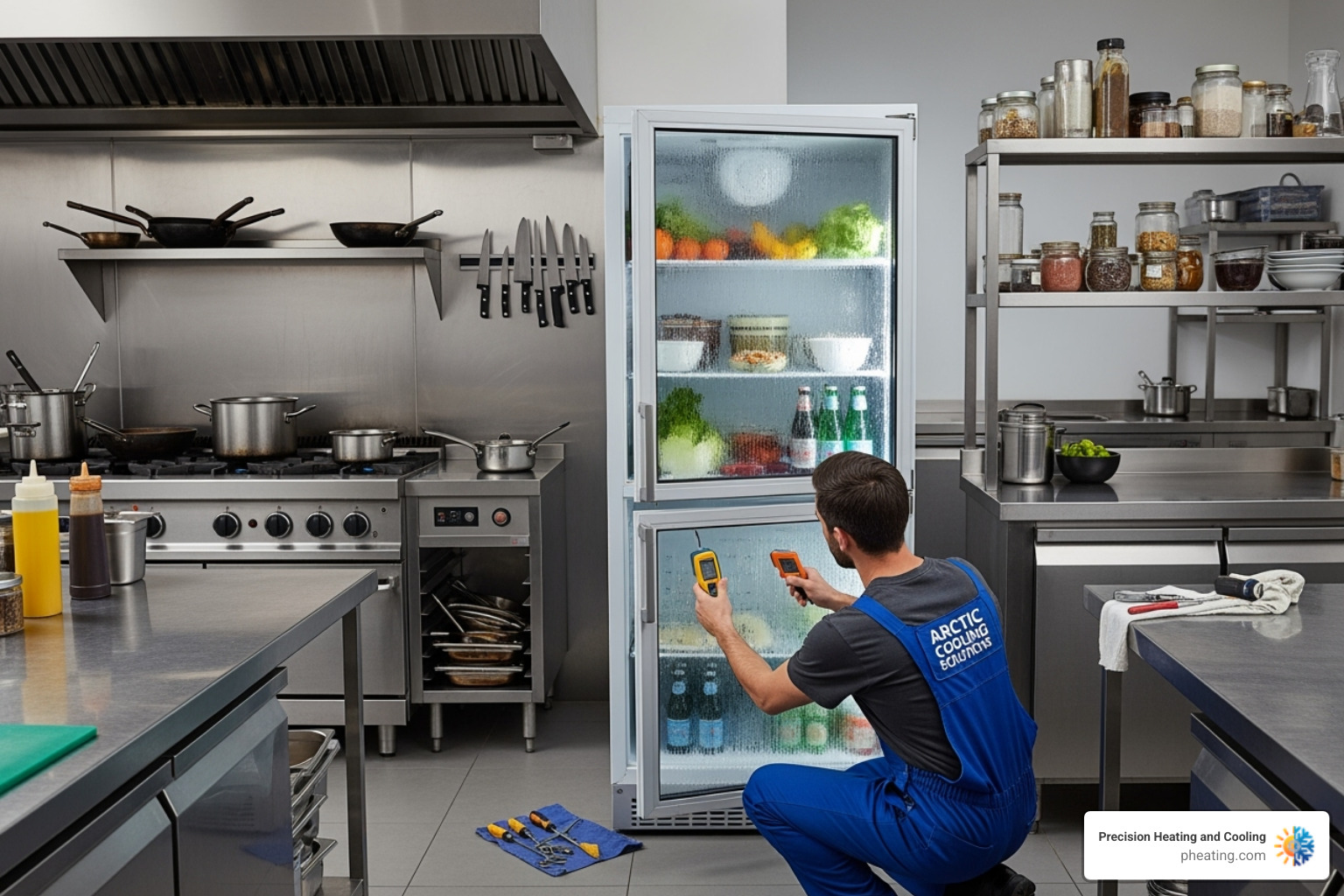








.avif)